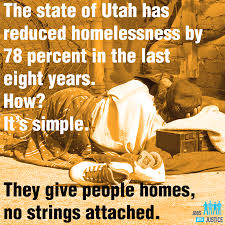Is it time to start thinking differently about homelessness? There’s a broad spectrum of approaches and opinions surrounding homelessness in the US and its assumed you are somewhere on that continuum. The Veteran’s Administration and Barack Obama have declared to end veteran homelessness by 2015, although results and progress remain to be seen. What if I told you, there is a state in the Union that is on target to eliminate homelessness by 2015? Is this a worthy goal and what are we really talking about here?
Since 2005, Utah has quietly begun to diminish homelessness and is on track to eliminate it by 2015. In the 8 years since it’s inception, Utah has dropped homelessness by 78%. What’s most interesting about it is that there  was no universe-shattering solution which defies the laws of economics, it was simple arithmetic. Legislators discovered that the annual cost of ER and jail visits cost almost $17,000/year per person while providing the same with an apartment and a social worker cost merely $11,000. Consequently, Utah began giving the homeless apartments and a case manager with no strings attached and the results are self-evident.
was no universe-shattering solution which defies the laws of economics, it was simple arithmetic. Legislators discovered that the annual cost of ER and jail visits cost almost $17,000/year per person while providing the same with an apartment and a social worker cost merely $11,000. Consequently, Utah began giving the homeless apartments and a case manager with no strings attached and the results are self-evident.
Typically, homelessness in America has been addressed through street outreach, food pantries, shelters, and religious activities. While this band-aid approach can alleviate some of the symptoms of homelessness, it rarely cuts to the root of the problems or provides a lasting solution. The Housing-First, also known as Rapid Re-Housing can provide dualistic benefits that improve the wellbeing of the homeless as well as the wellbeing of the neighborhood. By providing stable housing to the homeless, this program not only assists them by protects and improves the red-light districts, slums, and underpasses to provide increased community safety for the homeless and the surround.
The crux of this approach is almost a revolutionary concept in modern politics. The provision of a home and a case worker without expectations is counter-intuitive to the basic foundations of capitalism, yet Utah’s Housing First Model has reduced homelessness at an exponential rate and increased savings to the state in resolving a perpetual drain to the economy. It appears this housing first model can be successful on many fronts of the homelessness issue. For instance, while poverty is the assumed cause for the majority of homeless, in fact, there are a variety of causes which result in homelessness and often include traumatic loss. Mental health, substance abuse, and domestic violence remain the top causes for homelessness across the lifespan. Providing a housing first model allows for the possibility for redress of these conditions as seldom can a transient individual attain  consistent medications, keep consistent appointments, or find adequate services in any capacity. With the assistance of a caseworker, the root causes of homelessness have an opportunity to be addressed and further improvements can be seen. As opposed to providing shelter care with crowded bedding, random food pantries, and seldom successful street outreach, this model can give a real opportunity for rising out of poverty while providing safety for the homeless and the community simultaneously.
consistent medications, keep consistent appointments, or find adequate services in any capacity. With the assistance of a caseworker, the root causes of homelessness have an opportunity to be addressed and further improvements can be seen. As opposed to providing shelter care with crowded bedding, random food pantries, and seldom successful street outreach, this model can give a real opportunity for rising out of poverty while providing safety for the homeless and the community simultaneously.
Beyond the phenomenal 78% reduction in homelessness there are consistent strategies for self-sufficiency, as well as a $6,000/person reduction in costs to the state, this model has shown a serious impact for chronic homelessness and increased well-being. Similarly, several states are looking to implement this strategy and draw on the experiences gained from this Republican state. Are there any drawbacks to this approach? What’s your take on this “no-strings attached” approach to housing? Could housing be a human rights issue? Let’s discuss this significant and lasting social ill below.


